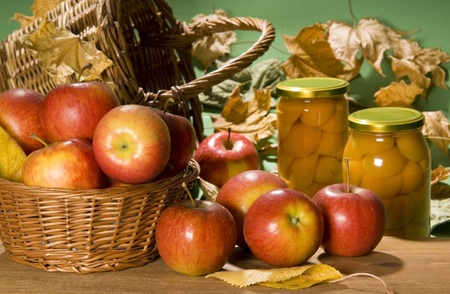Celebrating the Autumn Harvest in Britain
As the days gently shorten and a crispness fills the air, autumn in Britain unveils a season of abundance and tradition. Across the countryside and city allotments alike, hedgerows bristle with blackberries, orchards glisten with ripe apples, and fields yield golden squashes and root vegetables. This cherished time is marked by local festivals, farmers’ markets, and age-old customs that invite communities to come together in gratitude for nature’s bounty. The British autumn harvest is not merely about gathering crops; it is an opportunity to reconnect with the land, appreciate the rhythm of the seasons, and celebrate the nutritious gifts grown close to home. Embracing locally produced fruits and vegetables during this season not only supports sustainable farming but also enhances our wellbeing—making each meal a nourishing tribute to both tradition and health.
2. Seasonal British Produce: Whats in Abundance
As the crisp air of autumn settles across the British countryside, local markets and farm shops burst with a colourful array of freshly harvested produce. This season is truly a celebration of nature’s bounty, with fruits, vegetables, and grains that thrive in the UK’s temperate climate reaching their peak. Focusing on regionally grown favourites, let’s explore what the British autumn harvest brings to our tables.
Apples: The Quintessential British Fruit
Autumn is synonymous with apples in Britain. From the sweet Cox’s Orange Pippin to the tart Bramley cooking apple, orchards across Kent, Herefordshire, and Somerset are laden with ripe fruit. Apples are not only delicious but also provide vitamin C, dietary fibre, and beneficial polyphenols—making them an excellent addition to autumn diets.
Root Vegetables: Nutrient-Rich Staples
The cooler months signal the arrival of earthy root vegetables. Carrots, parsnips, swedes, and beetroots are staples in British kitchens during this season. Grown abundantly in regions like East Anglia and Lincolnshire, these vegetables are packed with vitamins A and C, potassium, and antioxidants.
| Vegetable | Main Region | Key Nutrients |
|---|---|---|
| Carrot | East Anglia | Vitamin A, Beta-Carotene |
| Parsnip | Lincolnshire | Fibre, Vitamin C |
| Swede | Scotland & North England | Potassium, Vitamin C |
| Beetroot | Nationwide | Folate, Iron |
Brassicas: Leafy Greens for Wellness
The brassica family—think cabbages, kale, broccoli and Brussels sprouts—flourishes as temperatures drop. These hearty greens are grown widely across Yorkshire and Lincolnshire fields. Brassicas are rich in folate, vitamin K, and sulphur-containing compounds known for supporting immune health during colder months.
A Gracious Grain Harvest
Apart from fruits and vegetables, autumn is also grain harvest time in Britain. Oats and barley ripen in the fields of Scotland and northern England, providing comforting porridge and nourishing breads throughout the season.
The Natural Bounty at a Glance
| Produce Type | Examples in Season | Main Benefits |
|---|---|---|
| Fruit | Apple, Pear, Plum | Antioxidants & Fibre |
| Vegetable (Root) | Carrot, Parsnip, Swede | Vitamins & Minerals |
| Vegetable (Leafy) | Cabbage, Kale, Sprouts | Immune Support & Folate |
| Grain | Oats, Barley | Sustained Energy & Fibre |
This seasonal abundance offers a natural opportunity to nourish our bodies while embracing the comforting flavours of a British autumn. By choosing locally grown produce at its freshest, we support both our wellbeing and our communities.

3. Nutritional Benefits of Autumn’s Bounty
As the British countryside turns golden and crisp, autumn brings a vibrant array of nourishing produce to our tables. This season’s harvest is not only a feast for the senses but also a wonderful source of key nutrients that support overall wellbeing. Let’s explore some of the nutritional highlights found in Britain’s autumn fruits and vegetables, and how they contribute to a balanced, healthful diet.
Rich in Vitamins to Support Immunity
Many classic British autumn crops—such as apples, pears, blackberries, and root vegetables like carrots and parsnips—are naturally high in essential vitamins. Apples and pears offer vitamin C, which helps protect cells and supports immune function during colder months. Root vegetables are excellent sources of vitamin A (as beta-carotene), known for maintaining healthy skin and vision. Including these seasonal staples in your meals can help bolster your body’s defences as daylight wanes.
Minerals for Energy and Balance
British-grown autumn vegetables such as kale, swede, leeks, and beetroot are packed with minerals like iron, potassium, and magnesium. Iron is particularly important for energy levels and cognitive function, while potassium helps regulate fluid balance and supports heart health. Magnesium is well known for aiding muscle relaxation and restful sleep—ideal as we adjust to shorter days.
Phytonutrients: Nature’s Plant-Based Boosters
The deep hues found in blackberries, red cabbage, pumpkins, and squashes signal the presence of phytonutrients such as anthocyanins and carotenoids. These plant compounds act as antioxidants, helping to reduce inflammation and protect against cell damage. Regularly including a rainbow of autumn produce in your diet provides a natural boost for long-term wellness.
By embracing locally grown autumn fruits and vegetables, you’re not only celebrating British food heritage but also nourishing your body with nature’s finest seasonal offerings. These nutrient-dense foods lay the foundation for comforting dishes that warm both body and spirit throughout the chilly months.
4. Mindful Shopping: Sourcing Fresh, Local Ingredients
Autumn in Britain brings an abundance of vibrant produce, making it the perfect time to embrace mindful shopping habits. By choosing ingredients that are in season and sourced locally, you not only enjoy peak flavour and nutrition but also help support local farmers and reduce your environmental footprint. Visiting farmers’ markets, greengrocers, or even farm shops allows you to connect with where your food comes from and make more sustainable choices.
Practical Tips for Seasonal Shopping
- Plan Ahead: Before heading out, jot down a list of seasonal produce to look for. This helps prevent food waste and ensures you make the most of whats fresh.
- Ask Questions: Don’t be shy to chat with stallholders or shopkeepers about how their produce is grown and harvested. They often have excellent advice on what’s at its best right now.
- Be Flexible: Let the harvest guide your menu. If you find a beautiful batch of British apples or earthy parsnips, adjust your recipes to include them.
- Support Local Growers: Look for labels indicating local farms or British-grown products, particularly at supermarkets, to keep your food miles low.
What’s in Season: A Quick Guide
| Vegetables | Fruits | Herbs & Others |
|---|---|---|
| Butternut squash Parsnips Cavolo nero Brussels sprouts Leeks |
Bramley apples Pears Plums Blackberries Damsons |
Sage Rosemary Horseradish root Chestnuts |
Sustainable Habits for Autumn Shopping
- Bring Your Own Bags: Reduce plastic use by taking reusable bags and containers for loose produce.
- Buy What You Need: Purchase smaller amounts more frequently to ensure everything stays fresh and nothing goes to waste.
- Preserve the Harvest: Consider freezing or preserving surplus fruits and vegetables for use later in the winter months.
Nourishing Body and Community
The British autumn harvest offers more than just delicious meals—it’s an opportunity to eat mindfully, foster community connections, and care for the environment. Each thoughtful purchase supports local agriculture and brings you closer to nature’s nourishing rhythms, helping you enjoy this abundant season in every sense.
5. Wholesome Autumn Recipes Inspired by British Traditions
As the evenings draw in and the crisp air sets a gentle pace, the British autumn kitchen comes alive with comforting aromas and nourishing flavours. Embracing locally grown produce not only supports our wellbeing but also honours centuries-old culinary traditions. Here is a selection of wholesome recipes that marry authentic British tastes with seasonal ingredients, all while keeping nutritional balance in mind.
Hearty Root Vegetable & Lentil Stew
This warming stew celebrates the humble roots of autumn—parsnips, carrots, swede, and potatoes—simmered gently with earthy lentils and fragrant herbs. A dash of Worcestershire sauce brings a distinctly British twist. Serve alongside wholegrain bread for added fibre and satisfaction.
Baked Bramley Apple & Blackberry Crumble
The classic crumble is an autumn staple across Britain. Using tart Bramley apples and freshly picked blackberries, this dessert offers a burst of antioxidants. Opt for a topping made from oats and ground almonds to boost heart-healthy fats and keep things naturally sweetened.
Mushroom & Barley Hotpot
Barley has long been a cherished grain in British cookery, valued for its nutty flavour and slow-releasing energy. Combine it with seasonal mushrooms, leeks, and a sprinkle of thyme for a soothing one-pot meal that’s both satisfying and rich in dietary fibre.
Roasted Squash & Chestnut Soup
Smooth and subtly sweet, this soup blends roasted butternut squash with British chestnuts—a nod to festive market traditions. Swirl in a little crème fraîche or natural yoghurt for creaminess, and serve with toasted pumpkin seeds for extra crunch and nutrients.
A Celebration of Seasonal Balance
Each recipe draws on the bounty of the British countryside, showcasing how simple, home-cooked meals can be both comforting and nutritionally balanced. By choosing local produce and traditional methods, we nurture our bodies and stay connected to the rhythms of nature throughout autumn’s golden days.
6. Bringing Autumn Wellness to Your Table
As the British countryside dons its russet and golden hues, autumn offers a delightful array of seasonal produce that can transform your daily meals into nourishing celebrations of wellbeing. Embracing nature’s bounty in your kitchen is not only a joy for the senses, but also a gentle way to support your health as the days grow shorter and cooler.
Tips for Embracing Autumn Produce
Start with Local and Seasonal Choices
Visit local farmers’ markets or farm shops to discover freshly harvested root vegetables, squashes, apples, pears, cabbages, and brassicas. By choosing what’s in season, you’ll enjoy ingredients at their peak flavour and nutrition while supporting local growers.
Create Colourful, Wholesome Plates
Bring vibrancy to your table by combining roasted carrots, parsnips, beetroot, and pumpkin with leafy greens like kale or spinach. Not only do these colours look inviting, but they also provide an array of antioxidants and vitamins essential for autumn wellness.
Make Simple Swaps for Comforting Dishes
Swap summer salads for warm grain bowls featuring pearl barley or quinoa mixed with roast autumn veg and a sprinkle of toasted seeds. A warming soup made from leeks, potatoes, and celeriac is both soothing and nourishing on chilly evenings.
Gentle Ways to Boost Wellbeing
Add grated apple or pear to your morning porridge for natural sweetness and fibre. Enjoy herbal teas infused with ginger or cinnamon to gently support digestion. For a wholesome snack, try slices of British cheese with crisp apples or oatcakes topped with homemade pumpkin spread.
Celebrate Togetherness Around the Table
Autumn is a wonderful time to gather loved ones around the table. Share hearty stews, baked apples, or root vegetable gratins that invite comfort and conversation. By focusing on fresh, natural ingredients and mindful preparation, you create meals that nurture both body and spirit throughout the season.


